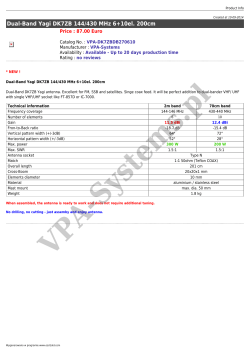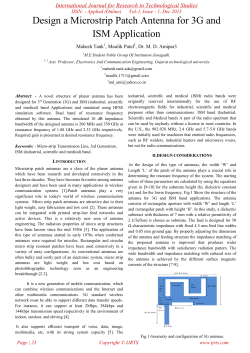
Multi-beam Patch Antenna Design Mustafa Konca Supervisor: Prof. Dr. Sener Uysal
Multi-beam Patch Antenna Design Mustafa Konca Supervisor: Prof. Dr. Sener Uysal Project Statement • • • • • • Design of a multi-beam patch antenna To be used in a security system Software simulations Field tests Modifications Lab tests The Security System Multi-Directional Patch Antenna Surveillance RF Link Solar Panel H.Q. The Security System • Autonomous Modules – Solar panels – Batteries – Intelligent software • Reliable Design • Flexibility • Fast Communication – Requires a well designed antenna The Module • Hexagonal pyramid design – Self Cleaning – Sturdy – Moving Sides Why Multi-Beam? • • • • • The Pyramid will be stationary Minimum number of moving parts required Antenna needs to transmit in different directions Antenna should cover a whole hemisphere This can be achieved with an antenna that has 5 beams in different directions at 45 degrees to each other • The antenna direction can be finely adjusted by moving the sides of the pyramid Why Patch? • Low profile – Resists wind and wear • Flexibility – Conformal shapes possible • Lightweight • Inexpensive • Ease of manufacture Why Multiband? • Reliability – Interference – Diversity • Environmental conditions • Speed Specification Objectives • Single design for all modules and locations • Dual band (ISM) – 2.4–2.5 GHz – 5.725–5.875 GHz • Five beams to cover a whole hemisphere – Selectable beams – Simultaneous if possible • Narrow beam-width for longer range • High Gain • Wide bandwidth for fast communication Design Approach • Option 1: A multilayer approach with many beams and a technique for suppressing the other • Option 2: Five antennas integrated as one antenna. • Both approaches are very challenging; such an antenna does not exist Design Steps • Use an existing element design • Design 5 separate antennas • Try to combine the antennas – Phased array • Design micro-strips to get necessary phase shift – Multilayer • Several antennas on top of each other • Switching to control the beam direction • Design a better element if time permits • Investigate the possibility of having more than one beam operational at the same time Simulations • First step will be simulating the single element which has high gain and directivity • Then the single element will be used in different configurations to get beams in 5 directions • Design Parameters: – – – – – – Material Distance to the ground plane Shape Feed type Stability Placement on the module Building the Antenna • Cost? • Hand made or fabricated? – Hand made design may not give accurate results – Multilayer design has to be fabricated • Need two for field tests • Connectors • Source and receiver Practical Tests and Tuning • Field tests – Confirm simulation results • Gain • Efficiency • Bandwidth etc. – Test under different conditions • • • • • Harsh weather Landscape and obstacles Different distances Signal integrity Interference from other devices – Tune and redesign if necessary and repeat all tests End of Presentation…. • Thank you for you time!
© Copyright 2025





















